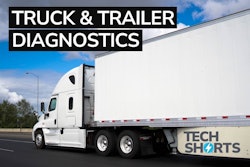In the evolving landscape of asset-based trucking, operational excellence is not just a goal but a necessity for growth and sustainability. The integration of Transportation Management Systems (TMSes), Electronic Logging Devices (ELDs), and Electronic Data Interchange (EDI) forms the digital foundation for modern carriers to thrive in 2024.
Homegrown systems of the early days
Initially, owner-operators and micro-fleets start with basic tools. Email, Excel spreadsheets, iMessage or WhatsApp, and simple accounting software are the norm. However, as a carrier moves off the spot market and grows, these systems quickly become inadequate.
The adoption of a TMS becomes vital–for ensuring profitable growth and for winning dedicated lanes based on your operation’s professionalism. The TMS acts as a centralized system, tying together dispatching, asset tracking, and driver settlements. This integration is crucial for carriers handling regional freight, especially those with a significant portion of their volume from direct or repeat customer relationships, such as in sectors like building materials, heavy machinery, or oilfield equipment.
For instance, Truckbase's functionality aligns well with the needs of carriers managing 10-100 trucks, simplifying dispatch and automating back-office tasks like invoicing and payroll. This shift to a more professional and technology-driven operation tends to be particularly appealing to emerging tech-savvy owners and operations managers keen on modernizing their business.
ELDs are more than compliance tools
The implementation of ELDs, mandated for compliance, offers more than just adherence to regulations. When integrated with systems like Truckbase, they offer real-time insights into fleet operations. As noted by Solomiya, Director at Nica’s Freight, “Integrating our Motive ELD with Truckbase was very easy. It’s incredible for dispatch to see real-time truck location in our TMS and to share live tracking with customers with a single click (or automatically!).”
This kind of integration allows for dynamic decision-making, enhancing route efficiency and providing customers with live updates – a crucial element in building trust and professionalism.
EDI: The bridge to customer integration
As you grow, integrating directly with your largest customers becomes essential to winning high volume and high paying lanes from large shippers & 3PLs.
EDI enables the seamless transfer of essential documents and data, reducing manual work and the potential for errors. This integration eliminates check calls & invoicing for that shipper and elevates your services to a digitally enabled carrier. Welcome to the big leagues!
Integrating EDI between your core TMS and your largest customers can automate load tendering, tracking updates, and invoicing. It also allows you to compete on reliability and compatibility, and not just price — thus can be a major factor in driving profitability.
Unified Systems: The key to strategic growth
The integration of your TMS, ELDs, and EDI is more than just a solution to operational challenges; it’s a strategic advantage. This unified approach allows for more efficient operations, enhanced customer service, and better decision-making. With systems like Truckbase, carriers can focus on scaling their operations without proportionally increasing their back-office staff.
Technology as a growth enabler
Fully integrated TMS, ELD, and EDI systems not only address current operational needs but also lay the foundation for future growth. They enable carriers to explore new markets, optimize their service offerings, and build stronger, more collaborative relationships with customers. Technology becomes a growth enabler, allowing carriers to compete effectively in an increasingly digital and connected world.
In conclusion, the integration of TMS, ELDs, and EDI systems is transforming the trucking industry. It enables carriers to move beyond the basics of compliance and operational efficiency to a realm where technology drives strategic growth and competitive advantage. As demonstrated by companies like Nica’s Freight, leveraging these technologies in a unified manner leads to significant improvements in operations, customer service, and business growth.












